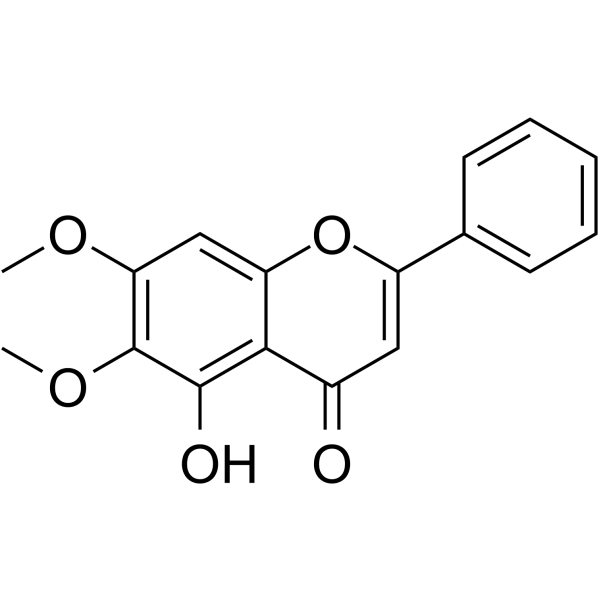天然产物 黄酮类 Flavonoids
Mosloflavone
Mosloflavone 从 Scutellaria baicalensis Georgi 中分离出的类黄酮,具有抗 EV71 活性。Mosloflavone 在病毒感染的初始阶段抑制 VP2 病毒复制和蛋白质表达,并抑制病毒 VP2 衣壳蛋白合成。 Mosloflavone 是有前途的杀菌剂,可抑制铜绿假单胞菌的毒力和生物膜形成。

Mosloflavone Chemical Structure
CAS No. : 740-33-0
| 规格 | 价格 | 是否有货 | |
|---|---|---|---|
| 5 mg | ¥4030 | 询问价格 & 货期 | |
| 10 mg | ¥6860 | 询问价格 & 货期 | |
* Please select Quantity before adding items.
| 生物活性 |
Mosloflavone is a flavonoid isolated from Scutellaria baicalensis Georgi with anti-EV71 activity. Mosloflavone inhibits VP2 virus replication and protein expression during the initial stage of virus infection and inhibits viral VP2 capsid protein synthesis. Mosloflavone is a promising biocide and inhibits P. aeruginosa virulence and biofilm formation. |
IC50 & Target |
IC50: EV71; bacterial[1][2] |
|---|---|
| 体外研究 (In Vitro) |
Mosloflavone shows promising anti-inflammatory activity via inhibition of TNF-α and IL-1β with IC50 values of 16.4 uM and 6.4 uM, respectively; inhibits TNF-α, IL-1β and iNOS levels in the supernatant of mouse macrophage cell line J774A as a dose-dependent manner, it also can be used as a starting point to discover lead structures for treatment of inflammatory and immunomodulatory diseases[2]. Shanghai Jinpan Biotech Co Ltd has not independently confirmed the accuracy of these methods. They are for reference only. |
| 分子量 |
298.29 |
| Formula |
C17H14O5 |
| CAS 号 |
740-33-0 |
| 运输条件 |
Room temperature in continental US; may vary elsewhere. |
| 储存方式 |
Please store the product under the recommended conditions in the Certificate of Analysis. |
| 参考文献 |
|
